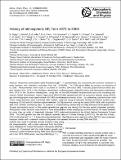History of atmospheric SF6 [SF subscript 6] from 1973 to 2008
Author(s)
Rigby, Matthew; Muhle, Jens; Miller, Benjamin R.; Prinn, Ronald G.; Krummel, P. B.; Steele, L. P.; Fraser, P. J.; Salameh, P. K.; Harth, C. M.; Weiss, R. F.; Greally, B. R.; O'Doherty, Simon; Simmonds, P. G.; Vollmer, M. K.; Reimann, S.; Kim, J.; Kim, K.-R.; Wang, H. J.; Olivier, Jos G. J.; Dlugokencky, E.; Dutton, G. S.; Hall, B. D.; Elkins, J. W.; ... Show more Show less
DownloadRigby-2010-History of atmospheric SF6 from 1973 to 2008.pdf (1.438Mb)
PUBLISHER_CC
Publisher with Creative Commons License
Creative Commons Attribution
Terms of use
Metadata
Show full item recordAbstract
We present atmospheric sulfur hexafluoride (SF6)[SF subscript 6] mole fractions and emissions estimates from the 1970s to 2008. Measurements were made of archived air samples starting from 1973 in the Northern Hemisphere and from 1978 in the Southern Hemisphere, using the Advanced Global Atmospheric Gases Experiment (AGAGE) gas chromatographic-mass spectrometric (GC-MS) systems. These measurements were combined with modern high-frequency GC-MS and GC-electron capture detection (ECD) data from AGAGE monitoring sites, to produce a unique 35-year atmospheric record of this potent greenhouse gas. Atmospheric mole fractions were found to have increased by more than an order of magnitude between 1973 and 2008. The 2008 growth rate was the highest recorded, at 0.29 ± 0.02 pmolmol−1 [pmolmol superscript -1] yr−1 [yr superscript -1]. A three-dimensional chemical transport model and a minimum variance Bayesian inverse method was used to estimate annual emission rates using the measurements, with a priori estimates from the Emissions Database for Global Atmospheric Research (EDGAR, version 4). Consistent with the mole fraction growth rate maximum, global emissions during 2008 were also the highest in the 1973–2008 period, reaching 7.4 ± 0.6 Gg yr−1 [yr superscript -1] (1-σ [1 - delta] uncertainties) and surpassing the previous maximum in 1995. The 2008 values follow an increase in emissions of 48 ± 20% since 2001. A second global inversion which also incorporated National Oceanic and Atmospheric Administration (NOAA) flask measurements and in situ monitoring site data agreed well with the emissions derived using AGAGE measurements alone. By estimating continent-scale emissions using all available AGAGE and NOAA surface measurements covering the period 2004–2008, with no pollution filtering, we find that it is likely that much of the global emissions rise during this five-year period originated primarily from Asian developing countries that do not report detailed, annual emissions to the United Nations Framework Convention on Climate Change (UNFCCC). We also find it likely that SF6 [SF subscript 6] emissions reported to the UNFCCC were underestimated between at least 2004 and 2005.
Date issued
2010-11Department
Massachusetts Institute of Technology. Center for Global Change ScienceJournal
Atmospheric Chemistry and Physics
Publisher
European Geosciences Union / Copernicus
Citation
Rigby, M. et al. “History of Atmospheric SF6 from 1973 to 2008.” Atmospheric Chemistry and Physics 10.21 (2010) : 10305-10320. © Author(s) 2010
Version: Final published version
ISSN
1680-7324
1680-7316